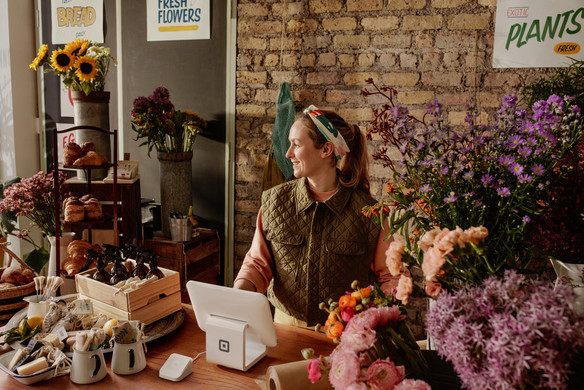Table of contents
As more customers moved to online shopping during the pandemic, retailers with brick-and-mortar locations had the potential to set themselves apart by offering the convenience of eCommerce with the personalization and experience of an in-person shopping trip.
Retailers are generally categorized in three different ways:
- Brick-and-mortar stores that operate solely from a physical location
- eCommerce that includes online shopping with no in-person shopping
- Click-and-mortar that combines brick and mortar with eCommerce.
Online and in-person retail have their own advantages. For example, brick and mortar offers customers the ability to experience products in person, which can be a bonus for items that are high-touch, such as furniture or clothing. On the other hand, online shopping offers consumers convenience — who doesn’t love to shop in their pajamas? It’s also a way to gather more information about products, especially when including videos or product specs. While 96% of Americans buy online, they spend 65% of their shopping budget in physical stores, according to Big Commerce.
It may be tempting to keep each type of commerce in its own lane, but retailers that take a click-and-mortar, digital-first approach may have an advantage when it comes to providing customers with the best level of service.
Why Digital First Retail?
There’s a good chance that your customers learned about you online, through social media, or checked out your website before heading to your location. According to Retail Dive, 87% of consumers research products via the web before buying, and 46% of shoppers say they prefer to buy in a physical location. If customers don’t find your digital presence, they may not know you exist.
Physical stores also offer a way for digital-first businesses to stand out in the marketplace and attract new consumers. A growing number of digital-native brands like Warby Parker, Third Love, and Untuckit have recently opened physical locations. The trend comes as a number of online, direct-to-consumer brands have grown and flooded the market. A physical site provides an online retailer with an additional way to interact with consumers, bringing a website to life. The strategy can also drive sales online due to improved brand awareness.
Physical locations can also be helpful for sectors that have a high return rate, such as clothing. According to Oracle’s “Retail in 4D” study, 73% of consumers surveyed want to return online purchases to a retail store. While no retailer loves returns, allowing customers to shop and return how they like can improve brand loyalty. And while the customer is in the store, sales associates have an opportunity to upsell or cross-sell, retaining the revenue.
How to Adopt a Digital-first Business Model
If you started your business online and are looking to build out a brick-and-mortar space that is cohesive with your online brand, the first step is to rethink the design of your store. Instead of stocking shelves with inventory that customers grab and carry to the checkout, digital-first retailers might prioritize kiosks or build a store like a showroom. Once a customer makes a purchase decision, the retailer can bring out the selected item from a backroom warehousing area or have it shipped to their home. A popular example of this model is Apple, who turned its retail locations into an experience instead of a traditional store. This model also helps maintain inventory levels across online and in-store product stock, which is often combined.
Another way to take advantage of a digital-first business model is to give sales associates access to customers’ profiles to build relationships. Customers want the same level of information and personalization available during their in-person visit as they have online. An Accenture survey found that 75% of respondents said they are more likely to buy from a business that does at least one of three things: recognizes them by name, recommends options based on past purchases, and knows their purchase history. Associates equipped with tablets can access a customer’s history with the brand, both online and in-store, making more targeted suggestions.
You can also implement a “try before you buy” service, also called reserve online, pick up in-store (ROPIS). Customers browse items online and have them set aside until they come to the store to try them, creating a digital-first experience. This personalized service saves the customer time and ensures the product they want will be there when they arrive. ROPIS is different from BOPIS (buy online, pick up in-store) because it doesn’t require an upfront payment. It offers an upsell opportunity since the customer interacts with the associate before completing the transaction, and reduces the risk of returns.
Digital-first Delivery
BOPIS became popular during the pandemic as shoppers tried to limit time spent in stores. An August 2020 survey from Digital Commerce 360 found that 43.7% of top-500 retailers with physical stores offered this delivery option compared to just 6.9% before the pandemic.
BOPIS combines the digital and in-store shopping experience, and it’s not going away any time soon. According to Oracle’s study, 55% of the consumers surveyed want to reserve something online for an in-store, same-day pickup. The method also benefits merchants who can engage with customers when they arrive to pick up their items, enhancing the shopper’s online experience.
Digital-first Payment Strategies
From reserving a purchase online and paying in the store to ordering an item in-store and having it shipped to their home, today’s consumers have become used to digital-first experiences. They want to continue to enjoy the convenience and ease. According to the Oracle study, 56% of consumers want to use self-checkout options, and 60% want to check out using mobile devices.
Adopting a digital-first payment strategy offers flexibility no matter where the customer chooses to complete the transaction. One place to start is implementing QR codes or other contactless payment methods.
When you take a digital-first business approach, you can meet the needs of modern consumers that consider your online presence an important part of their buying journey.
![]()












